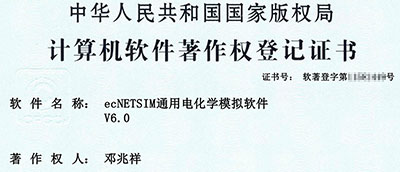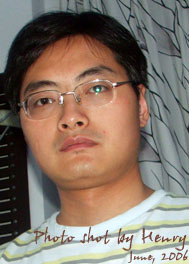| The
following are some programs developed by Zhaoxiang
Deng during his Ph.D. thesis work with Prof.
Xiangqin Lin.
(1) EC-NETSIM 1.0
When used in conjunction with an electronic simulator such
as PSpice, this
software can serve to simulate virtually any electrochemical problems
that can be approximated by Butler-Volmer electron-transfer kinetics
coupled with arbitrarily complicated homogeneous chemistry at a planar,
spherical, cylindrical or rotating-disk electrode. Simulation of a
purely surface-confined process has also been made possible. The basic
idea in building this program is to transfer electrochemical problems
into electric circuit networks that can be readily solved by an electronic
simulation package. Hence at least a free student version of the PSpice
package is needed to fulfill basic simulations. Some other programs
within the Spice
family available on the internet may work for limited cases (in other
cases either memory or convergence will be a problem). The author
strongly suggests a full version of PSpice
(version 5.0 or later) in order to achieve a fully functioning simulator.
EC-NETSIM 1.0 is available for free (AS COPYRIGHTED FREEWARE)
assuming the program is in its entirety and a specified reference
(see following) has been properly cited in any related publications.
Note: EC-NETSIM can only help you convert your
specific electrochemical problems into PSpice
netlist files. Therefore EC-NETSIM is only suitable for those who
already or will have access to a PSpice
program that can do the rest part of the simulation job for you.

Please cite this paper if you
are going to publish any data produced with the help of EC-NETSIM:
Zhao-Xiang Deng, Xiang-Qin Lin, Zhong-Hua Tong, "Universal electrochemical/chemical
simulator based on an exponentially expanding grid network approach",
Chinese J. Chem. 22, 719~726, 2004
(PDF)
Other EC-NETSIM related papers:
1) Zhao-Xiang Deng, Xiang-Qin Lin, Zhong-Hua Tong, "Exponentially
expanded grid network approach: validity for simulation of electrochemical
transient process on spherical, cylindrical and rotating disk electrodes",
Chinese J. Chem. 23 (2), 166~172, 2005
2) Zhao-Xiang Deng, Xiang-Qin Lin, Zhong-Hua Tong, "Exponentially
expanded grid network approach: validity for simulation of stiff electrochemical
problems", Chinese J. Chem. 21, 1137~1145,
2003
3) Zhao-Xiang Deng, Xiang-Qin Lin, Zhong-Hua Tong, "An algorithm
for judgment of the thermodynamic self-consistency of an electrochemical/chemical
reaction system", Acta Chimica Sinica, 60(8),
1415~1418, 2002
4) Zhao-Xiang Deng, Xiang-Qin Lin, "Digital simulation by network
approach for the cyclic voltammograms with the electroactive species
partially adsorbed at the electrode surface", Chin. J. Anal.
Chem. 28(8), 930~935, 2000
5) Zhao-Xiang Deng, Xiang-Qin Lin, "Simulation of ultra-fast
voltammograms by network approach", Chin. J. Anal. Chem.
27(12), 1376~1380, 1999
Some application examples of EC-NETSIM:
1) Wei Wang, Hua Cui, Zhaoxiang Deng, Yongping Dong, Jizhao Guo, "A
general E-E/C mechanism for the counter-peak in luminol electrochemiluminescence",
J. Electroanal. Chem. 612, 277-287, 2008
2) Zhao-Xiang Deng, Zhong-Hua Tong, Xiang-Qin Lin, "Global evaluation
of linear sweep voltammetric responses with electroactive species
confined at the electrode surface", J. Electroanal. Chem.
568, 235~245, 2004
3) Xiayan Wang, Zhaoxiang Deng, Baokang Jin, Yupeng Tian, Xiangqin
Lin, "Study on the spectroelectrochemical properties of S-benzyl-N-(ferrocenyl-1-methyl-metylidene)-dithio-
carbazate nickel (II) complex", Spectrochim. Acta (A),
58, 3113~3120, 2002
4) Xiayan Wang, Zhao-Xiang Deng, Baokang Jin, Yupeng Tian, Xiang-Qin
Lin, "Electrochemical and in-situ SNIFTIR Spectroscopic Studies
of Palladium (II) and Zinc (II) Schiff Base Complexes: Structural
Control on the Electronic Communication between Two Identical Redox
Sites", Bull. Chem. Soc. Japan, 75(6),
1269~1273, 2002
5) Xiayan Wang, Zhao-Xiang Deng, Baokang Jin, Yupeng Tian, Xiang-Qin
Lin, "Electrochemical and in situ FTIR Studies of Biferrocene
Trinuclear Platinum Complex", Electrochim. Acta, 47,
1537~1543, 2002
(2) WAVE 98
This is a software that can be used to transfer waveform
data from a Tektronix TDS340 digital oscilloscope (should work with
other models after minor revisions) to a PC via a standard RS232 port.
It was originally built for an ultrafast voltammetric system using
TDS340 for high speed data recording.
(3) Various small programs
written in Turbo C 2.0 for electrochemical simulations (see following
publications).
1) Zhao-Xiang Deng, Xiang-Qin Lin, Zhong-Hua Tong, "Single alternating
group explicit (SAGE) method for electrochemical finite difference
digital simulation", Chin. J. Chem. 20(3),
252~262, 2002
2) Zhao-Xiang Deng, Wei Zhao, Xiang-Qin Lin, "Simplex optimization-numerical
simulation method for FCV curve fitting", Chin. J. Anal.
Chem. 27(4), 383~387, 1999
3) Zhao-Xiang Deng, Xiang-Qin Lin, "Digital simulation of fast
cyclic voltammograms by integration of the double layer charging current",
J. Electroanal. Chem. 464(2), 215~221, 1999
4) Xiang-Qin Lin, Zhao-Xiang Deng, "An improved electrochemical
numerical simulation for the characterization of the influences of
uncompensated solution resistance on cyclic voltammograms." J.
Anhui Normal Univ.21(4), 333~338, 1998
To require a free copy of our EC-NETSIM
program please feel free to contact:  Dr.
Zhaoxiang Deng. Dr.
Zhaoxiang Deng.
Current ecNetSim users are from:
1) China (University of Science and Technology of China)
2) USA (Stanford University)
3) Argentina (Universidad Nacional de Rio Cuar)
4) Malaysia
5) Pakistan (University of Engineering & Technology)
6) Belgium (IMEC research center)
7) India (Dept of EC, SJCIT at VTU)
8) Ethiopia (Dept of Chem, Addis Ababa University)
9) Egypt (Chemistry Department, Tanta University)
10) Thailand (Physics Department, Mahidol University)
|
 Programs
Programs